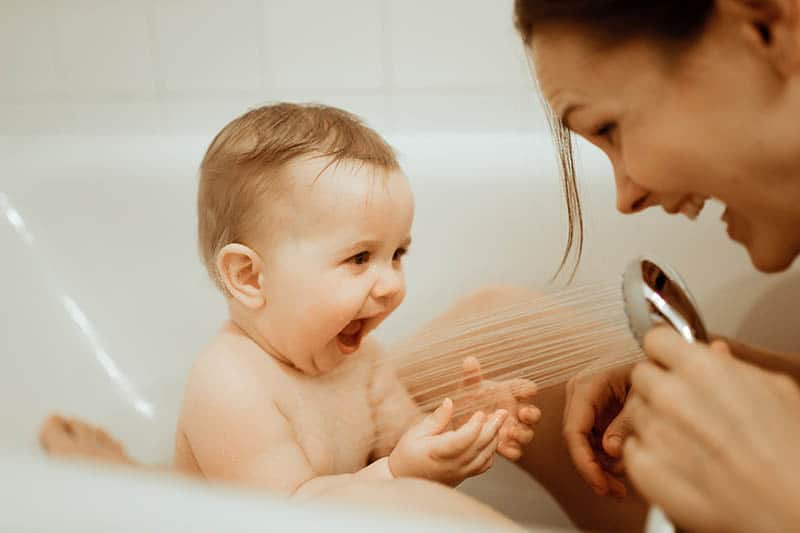A lot of new moms often ask themselves, “When is the best time to start showering baby?”
The answer is quite simple: As soon as the umbilical cord stump left around your baby’s belly button falls off (usually it happens between 10 days to 3 weeks), it’s safe to do so.
Until then, stick to sponge baths, but even those don’t need to be done every day.
Unlike you, the baby’s skin is a lot more sensitive to frequent rinsing and washing, and can develop irritations and rashes easily or make the skin dry.
Besides, they don’t need a bath or shower daily.
Some of the bacteria forming on their skin is necessary for their growth and development and those washes aren’t helping that.
With all that out of the way, let’s begin by going through what one shower looks like.
A Day In The Life Of A New Mom: Showering Baby Edition
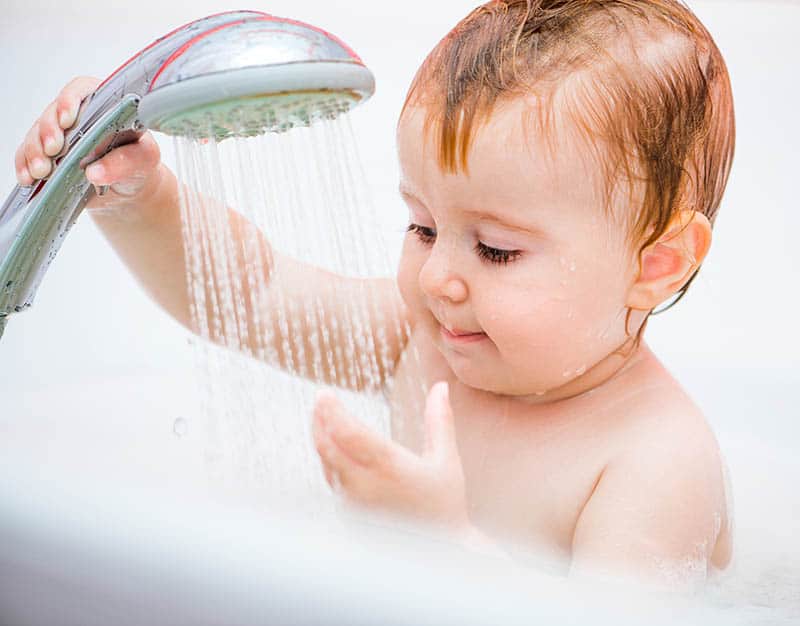
Now, seeing as this is their first time, I suggest doing it together with your husband so you can get used to it and so your little one can quickly escape into a pair of dry hands and a towel if things get too intense.
This is how I did it with both of my kids and it’s much safer than doing it alone.
The pressure might get to you and you might start making mistakes.
That said, your hubby won’t be around every time since someone has to work, so don’t go around expecting his assistance each time.
You are a mom after all. You are strong, don’t forget that.
But even the best of moms need help from time to time, so don’t be afraid to ask a close friend or family member for help.
Someone who you trust.
Before you enter
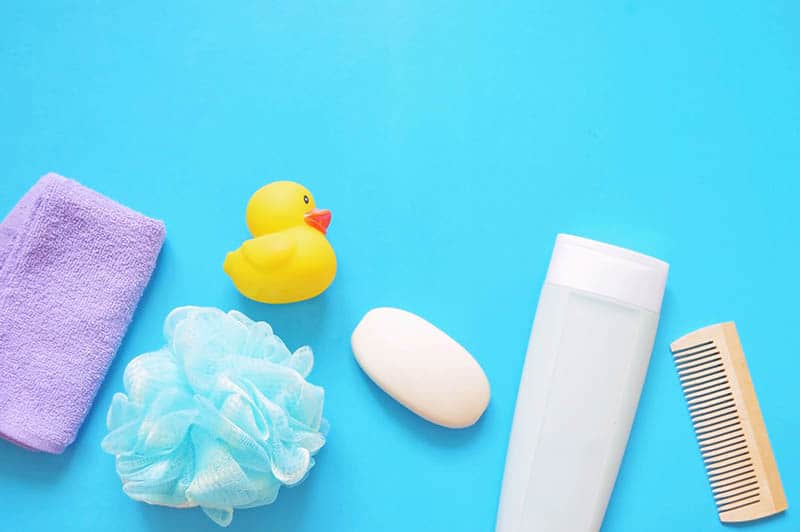
RELATED: Best Baby Washcloths & Towels: 11 Top Choices For Your Little One
Also make sure that you have everything you need nearby so you don’t have to walk around the shower stall (bathtubs are less of an issue, but still).
I had a little baby basket installed where I kept all of their toys, shampoo, and soap, so it doesn’t get mixed up with all of our other stuff.
I’d suggest you do the same purely to make the process easier.
Getting in
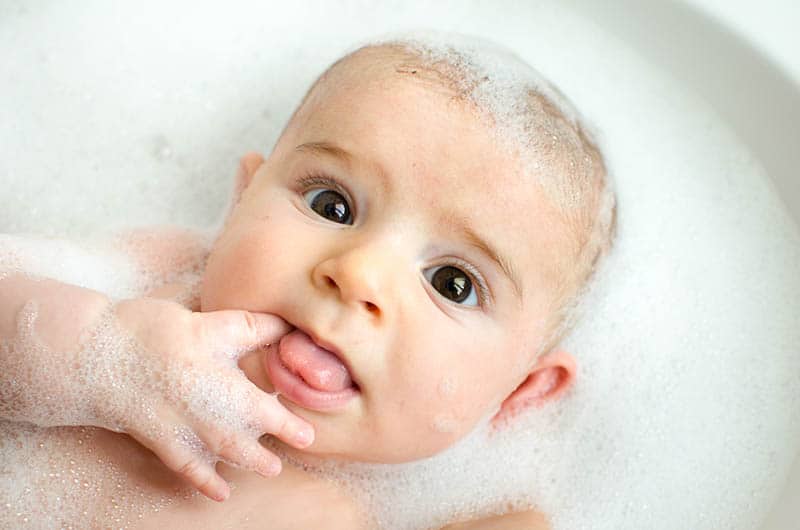
This is where the biggest risk exists, as getting in poses a danger of slipping.
And slipping with a baby in hand… not really the best thing.
Here is where I want to emphasize the fact that you need to enter the bath/shower alone first.
Place the baby in your partner’s care while you enter/exit and then have them hand the baby over once you get settled.
If you’re doing this alone, a baby bouncer is a good item to have to put the baby in while you make the transition.
But don’t leave the baby unattended for even a second.
They’re still young and unaware of many things around them. They might panic and hurt themselves.
That said, the first baby shower will definitely be hectic and full of screaming and jostling.
Don’t be scared, you’re probably not doing anything wrong, it’s just a natural way the baby’s going to act to a new experience.
Remember, your little ones are just that – little – so everything else is massive to them in comparison and really, really scary.
Back on topic.
If you want to reduce any potential slipping, get yourself a shower mat in case of a shower stall, or if you own a bathtub, get a bathtub seat so you can remain comfortable and stationary, and not slip on the soapy suds below.
Once you’re in
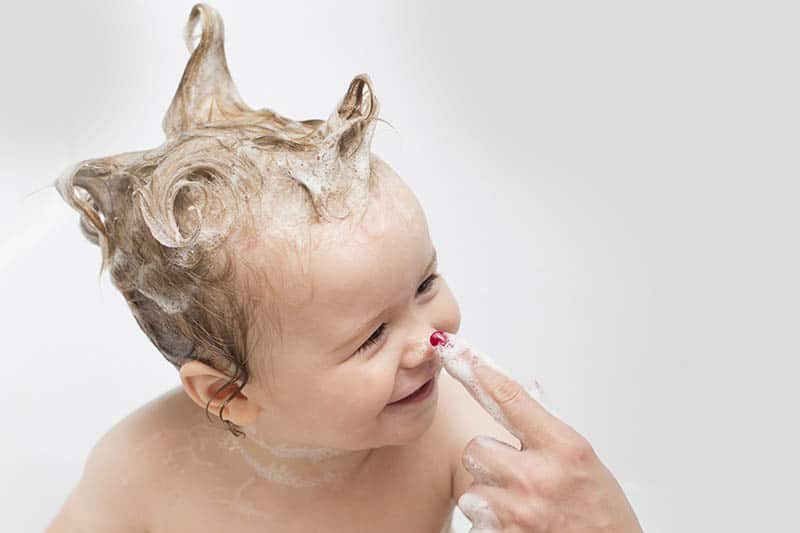
This is where the next step comes into play.
Make sure the water temperature stays between 90-100°F (or 36-38°C, depending on what you’re used to).
Do this before you take the baby from your partner’s embrace, the bouncer, or whatever other place she’s being kept safe in while you get all of this ready for her.
Yes, it may be colder than what you’re used to, but remember, your baby is more sensitive to this than you are.
This is why having temperatures that are close to body temperature are the most ideal.
This is also the preferred temperature as prescribed by the CPSC and one would assume they know what they’re talking about.
You can do this by feel, but to be extra safe, get a bathroom thermometer to measure the temperature.
Once you’ve made the necessary precautions of securing child-safe warm water, it’s time to take the baby into your arms for baby bath time.
Make sure to turn the shower head away from your baby’s face.
If you can adjust the speed of your shower’s water flow, then put it to a slower spill to keep it gentler for your baby’s skin.
Now that that’s sorted, it’s time for some washing and shampooing.
Again, what works for you may not work for your child (this is why I said that having a separate basket was a good thing).
Get some baby-friendly shampoo and body wash that won’t irritate their eyes or tear ducts. You may want to invest in a baby washcloth as well, something that has a softer touch than your own hand when it comes to application.
One simple hack that you can do to make all of this easier – as you’ll only realistically have one hand free throughout this entire ordeal – is to take the bottle of body wash and pour it over into a clean soap dispenser or shampoo pump.
This way you won’t have to struggle with opening bottles that sacrifice practicality for looks; you can just do a few simple thumb presses and be ready to apply.
Getting out
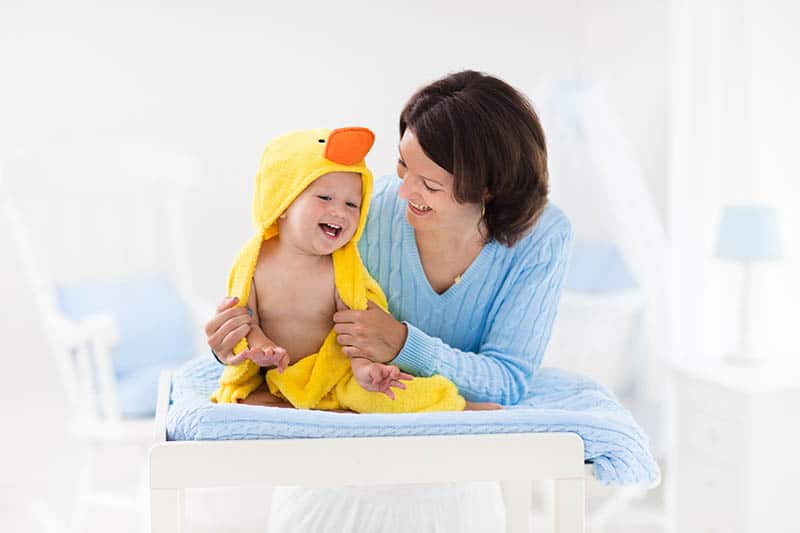
Make sure the water is drained and that the baby is properly secured, either in your partner’s or friend’s arms that have a dry towel ready to take the baby in, or in a baby bouncer.
Once baby is safe, get yourself out slowly and get yourself dry before taking the baby and getting them dressed with a fresh nappy and a warm blanket.
Don’t let them stay out in the cold too long.
And there we go, that’s it! Your first showering baby experience.
It may seem complicated, but once you get the gist of it, you’ll do just fine.
Potential Hazards To Look Out For
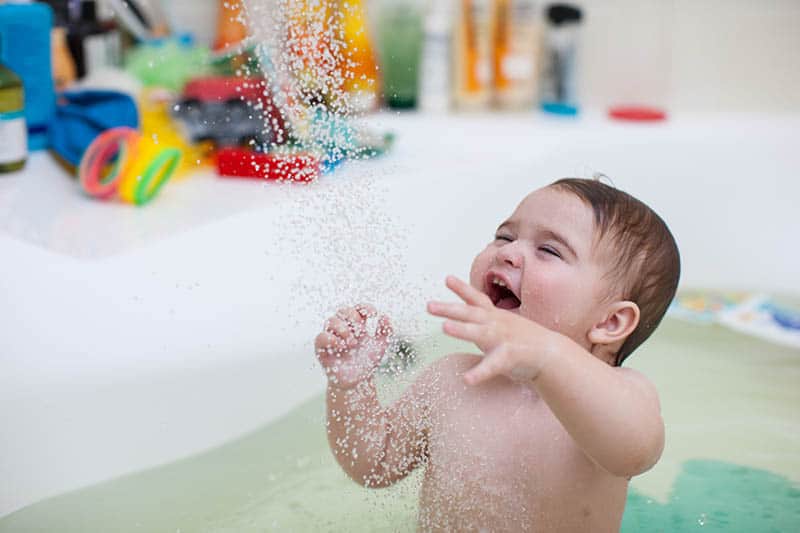
Make sure everything is ready.
Not being prepared can ruin your showering experience rather quickly as you realize you’ve forgotten either a towel or to get the shampoo within reach.
Co-shower with your partner when possible.
In the case of a large enough tub/shower stall, it’ll make things much easier to manage and you get some bonus family bonding time going.
Get in and out of the shower/tub alone.
Do not hold the baby in your hands when doing so under any circumstances.
They can go without a shower if you can’t afford to set them down somewhere when you have to enter/exit.
Be careful not to slip.
Bathroom surfaces can be deadly – doubly so when it’s baby shower time.
Take it slow when entering and be careful where you step.
Make sure the temperature stays between 90-100°F. As mentioned earlier, a baby’s skin is very sensitive.
Make sure to practice proper skin-care, not just in this manner of potentially scalding your little one, but when drying them off and outside of the shower as well.
Don’t use shampoo that you use yourself.
Stick to baby-safe shampoos and body washes when it comes to your baby – ones that won’t irritate their tear ducts or any other part of their body during bath time.
Don’t leave your baby unattended at any point in time.
This should go without saying, but in a bathroom setting, there are great risks of your baby swallowing something that they shouldn’t or sucking on something that might end up getting them sick or worse.
It’s a hazard-prone area and your baby should be under constant supervision.
Don’t use scented soaps, epsom salts, or bubble baths.
A baby is much more susceptible to getting irritated from fragrances and bubbles despite finding them rather fun.
The suds itself can end up creeping into some unwanted spots and causing infections if not cleaned out properly.
Stick to baby-safe options and keep showers plain.
Don’t take too long. Babies don’t need too long under the shower.
This takes us back to the skin-care bit. If you take too long, their skin will get pruney and more prone to drying out.
Just a few minutes and you should be set.
What To Do To Make It Safer?

Get a shower mat or a bathtub seat.
This will make your life so much easier, reducing the chance of you slipping in the shower and giving you a secure spot to stand or sit on in the tub that still gets enough water coverage.
It lets you alleviate your worries of slipping around with your little one.
Use a soap/shampoo pump.
Unloading showering liquids into a pump/dispenser gives you easy access to soap and shampoo when you need it, without needing to open and close cumbersome bottle caps.
Learn to carry your baby around with one hand.
This is the most important tip, as this is what you’ll be doing throughout the entire showering process.
Don’t even attempt showering baby without mastering this.
They’ll be fine without a shower; they won’t be fine with an injury.
Get a separate space for their shower stuff.
Their own shampoos and body washes, their washcloth, and a toy or two to keep them busy and distracted while showering.
Get a bath thermometer to monitor the temperature.
So you don’t have to do it by feel, grab this to make adjusting the shower temperature much quicker.
Get them a baby bath tub. If you can’t handle taking them into your own shower, buy them a bath tub of their own.
This way you don’t have to get too wet and can manage their bath time better.
Take a shower before them. The goal of showering baby isn’t to take a shower yourself and don’t consider it as such.
If you need a shower, do it separately. You’re just giving yourself extra work otherwise.
Only bathe your baby twice a week.
I’ve mentioned this before: For proper baby-care, you have to let some of the bacteria remain to help the baby’s skin grow more resistant and keep it from drying out.
In the end, until they swap to some more solid foods, they don’t really need too many baths.
In conclusion
Showering baby can be the best and worst of times. Make sure to take every precaution.
Practice a few times with your partner at first until you get the hang of it, and then you can swap to soloing it.
Still take co-showers when possible so you don’t have to stress about it on your own, and make sure the baby is safe at all times.
That’s it from me this time, mamas.
I hope this helps you in making showertime a happy time for both you and baby.
READ NEXT: Best Baby Lotions: 25 Top Choices For Your Little One
Like this post? Please share or pin it for later. You can also stay in the loop and follow us on Facebook, Instagram and Pinterest.
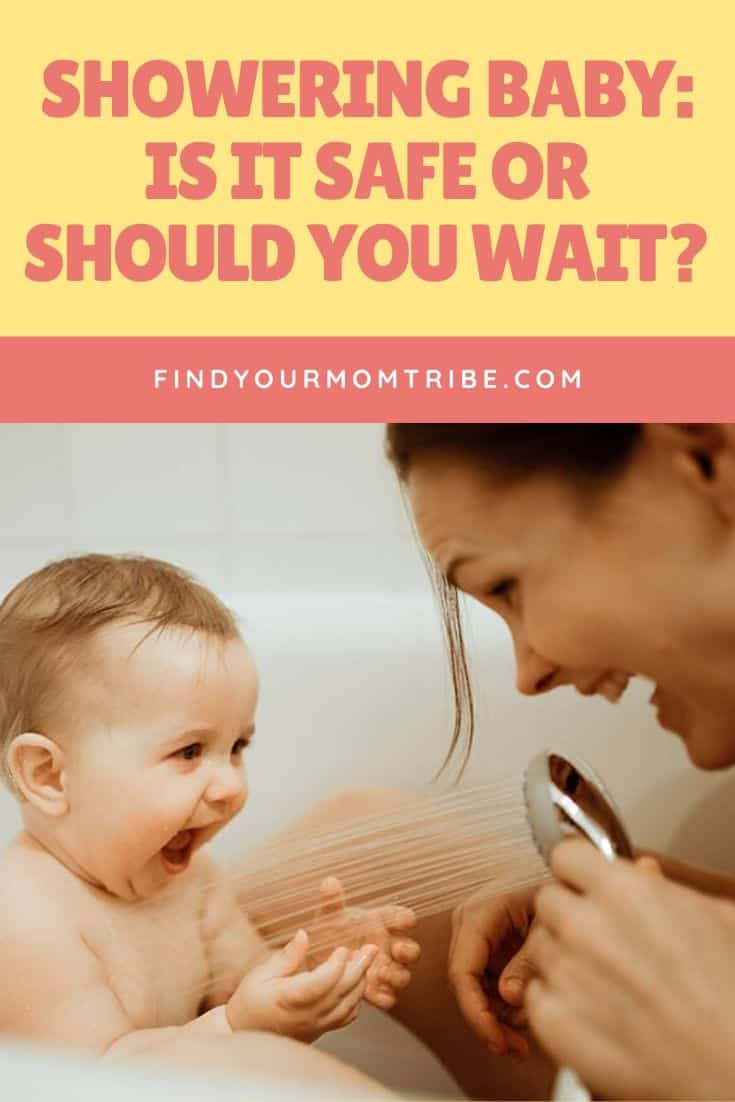
This post contains affiliate links. Please see our full disclosure for more info.

